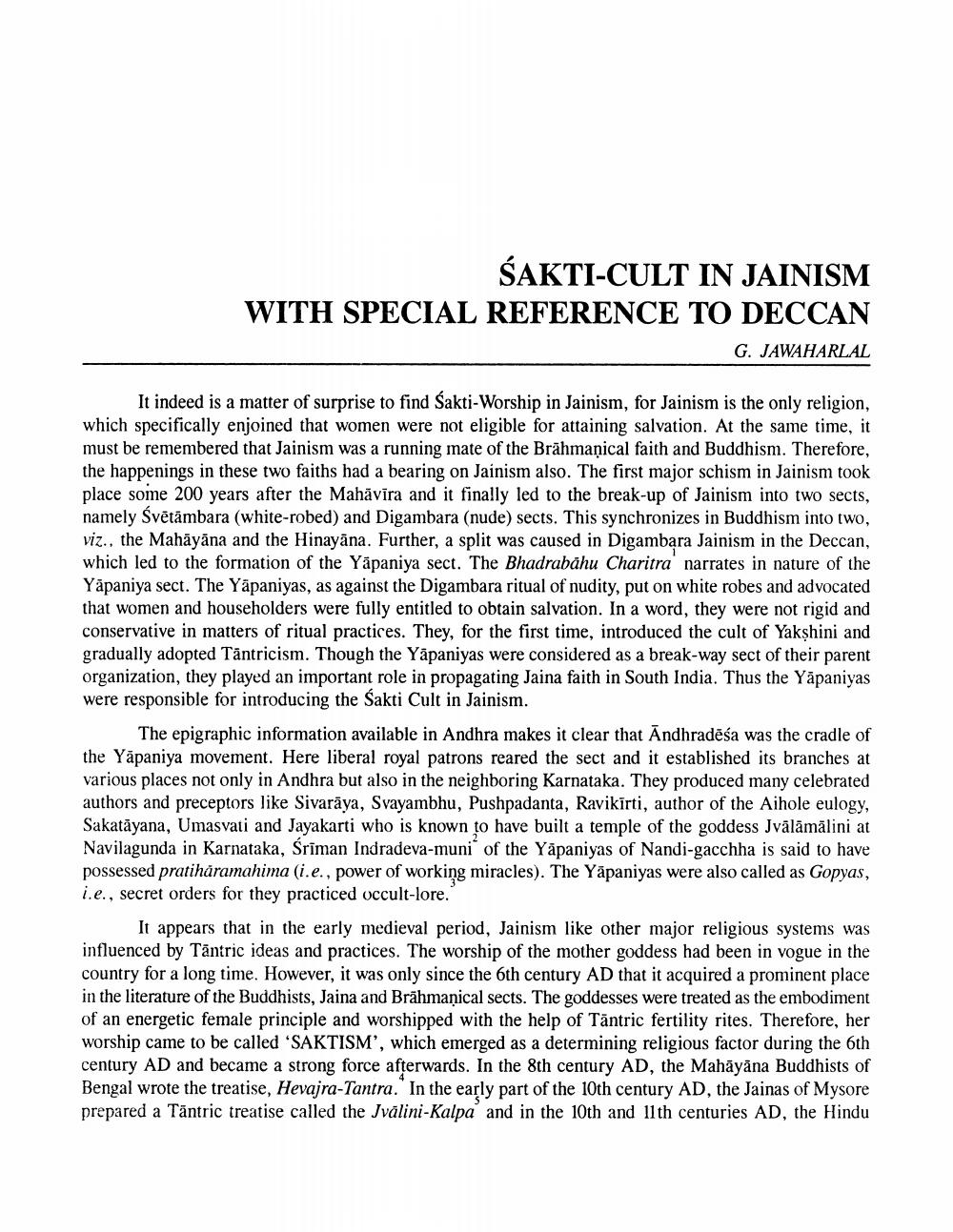________________
ŚAKTI-CULT IN JAINISM WITH SPECIAL REFERENCE TO DECCAN
G. JAWAHARLAL
It indeed is a matter of surprise to find Sakti-Worship in Jainism, for Jainism is the only religion, which specifically enjoined that women were not eligible for attaining salvation. At the same time, it must be remembered that Jainism was a running mate of the Brahmanical faith and Buddhism. Therefore, the happenings in these two faiths had a bearing on Jainism also. The first major schism in Jainism took place some 200 years after the Mahāvīra and it finally led to the break-up of Jainism into two sects, namely Svētāmbara (white-robed) and Digambara (nude) sects. This synchronizes in Buddhism into two, viz.. the Mahāyāna and the Hinayana. Further, a split was caused in Digambara Jainism in the Deccan, which led to the formation of the Yapaniya sect. The Bhadrabahu Charitra narrates in nature of the Yapaniya sect. The Yapaniyas, as against the Digambara ritual of nudity, put on white robes and advocated that women and householders were fully entitled to obtain salvation. In a word, they were not rigid and conservative in matters of ritual practices. They, for the first time, introduced the cult of Yakshini and gradually adopted Tantricism. Though the Yapaniyas were considered as a break-way sect of their parent organization, they played an important role in propagating Jaina faith in South India. Thus the Yapaniyas were responsible for introducing the Sakti Cult in Jainism.
The epigraphic information available in Andhra makes it clear that Andhradeśa was the cradle of the Yapaniya movement. Here liberal royal patrons reared the sect and it established its branches at various places not only in Andhra but also in the neighboring Karnataka. They produced many celebrated authors and preceptors like Sivaraya, Svayambhu, Pushpadanta, Ravikirti, author of the Aihole eulogy, Sakatayana, Umasvati and Jayakarti who is known to have built a temple of the goddess Jvälämälini at Navilagunda in Karnataka, Śrīman Indradeva-muni of the Yapaniyas of Nandi-gacchha is said to have possessed pratiharamahima (i.e., power of working miracles). The Yapaniyas were also called as Gopyas, i.e., secret orders for they practiced occult-lore."
It appears that in the early medieval period, Jainism like other major religious systems was influenced by Tantric ideas and practices. The worship of the mother goddess had been in vogue in the country for a long time. However, it was only since the 6th century AD that it acquired a prominent place in the literature of the Buddhists, Jaina and Brahmanical sects. The goddesses were treated as the embodiment of an energetic female principle and worshipped with the help of Tantric fertility rites. Therefore, her worship came to be called 'SAKTISM", which emerged as a determining religious factor during the 6th century AD and became a strong force afterwards. In the 8th century AD, the Mahayana Buddhists of Bengal wrote the treatise, Hevajra-Tantra." In the early part of the 10th century AD, the Jainas of Mysore prepared a Tantric treatise called the Jválini-Kalpa and in the 10th and 11th centuries AD, the Hindu




